2016 NISSAN MAXIMA instrument panel
[x] Cancel search: instrument panelPage 284 of 401
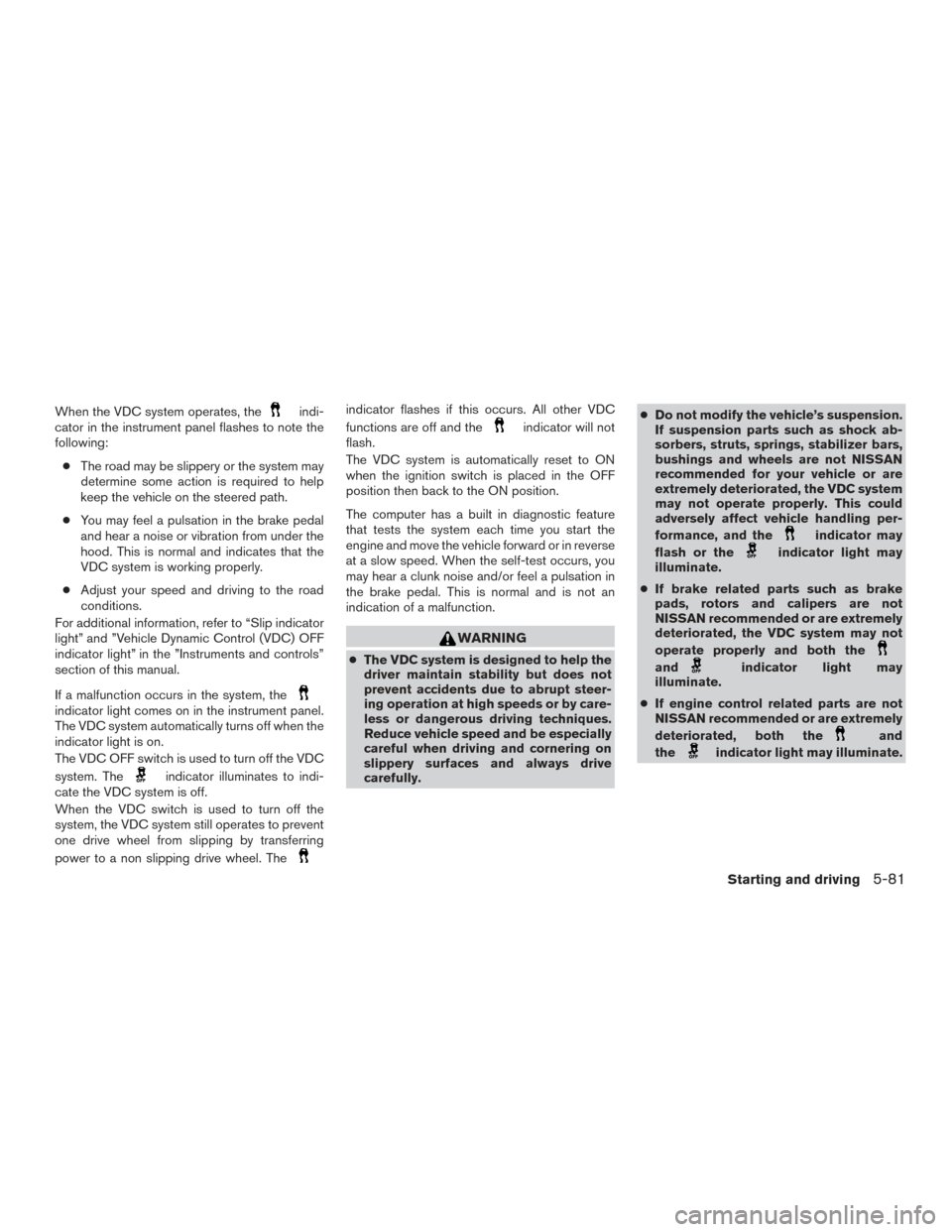
When the VDC system operates, theindi-
cator in the instrument panel flashes to note the
following:
● The road may be slippery or the system may
determine some action is required to help
keep the vehicle on the steered path.
● You may feel a pulsation in the brake pedal
and hear a noise or vibration from under the
hood. This is normal and indicates that the
VDC system is working properly.
● Adjust your speed and driving to the road
conditions.
For additional information, refer to “Slip indicator
light” and ”Vehicle Dynamic Control (VDC) OFF
indicator light” in the ”Instruments and controls”
section of this manual.
If a malfunction occurs in the system, the
indicator light comes on in the instrument panel.
The VDC system automatically turns off when the
indicator light is on.
The VDC OFF switch is used to turn off the VDC
system. The
indicator illuminates to indi-
cate the VDC system is off.
When the VDC switch is used to turn off the
system, the VDC system still operates to prevent
one drive wheel from slipping by transferring
power to a non slipping drive wheel. The
indicator flashes if this occurs. All other VDC
functions are off and the
indicator will not
flash.
The VDC system is automatically reset to ON
when the ignition switch is placed in the OFF
position then back to the ON position.
The computer has a built in diagnostic feature
that tests the system each time you start the
engine and move the vehicle forward or in reverse
at a slow speed. When the self-test occurs, you
may hear a clunk noise and/or feel a pulsation in
the brake pedal. This is normal and is not an
indication of a malfunction.
WARNING
● The VDC system is designed to help the
driver maintain stability but does not
prevent accidents due to abrupt steer-
ing operation at high speeds or by care-
less or dangerous driving techniques.
Reduce vehicle speed and be especially
careful when driving and cornering on
slippery surfaces and always drive
carefully. ●
Do not modify the vehicle’s suspension.
If suspension parts such as shock ab-
sorbers, struts, springs, stabilizer bars,
bushings and wheels are not NISSAN
recommended for your vehicle or are
extremely deteriorated, the VDC system
may not operate properly. This could
adversely affect vehicle handling per-
formance, and the
indicator may
flash or the
indicator light may
illuminate.
● If brake related parts such as brake
pads, rotors and calipers are not
NISSAN recommended or are extremely
deteriorated, the VDC system may not
operate properly and both the
andindicator light may
illuminate.
● If engine control related parts are not
NISSAN recommended or are extremely
deteriorated, both the
and
the
indicator light may illuminate.
Starting and driving5-81
Page 378 of 401
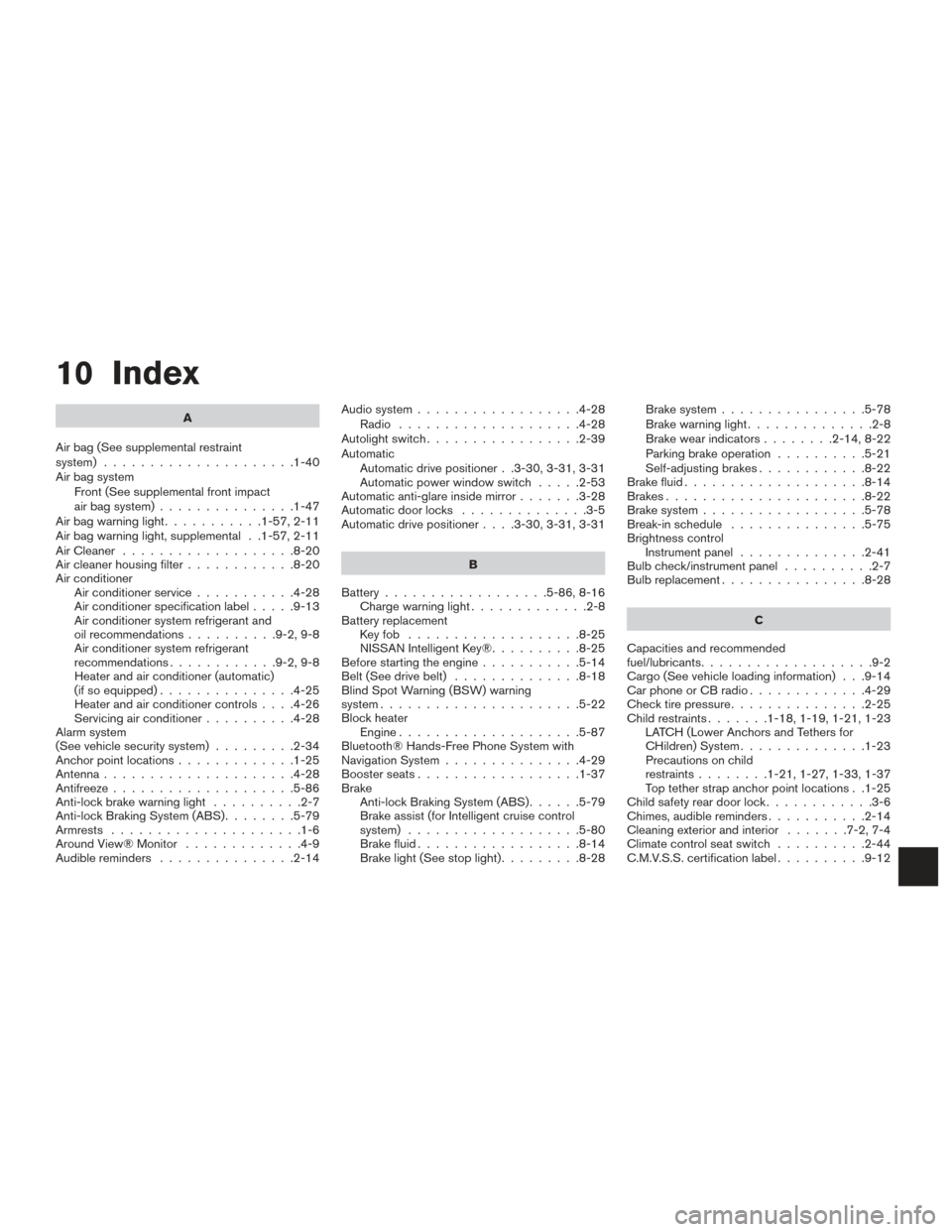
10 Index
A
Air bag (See supplemental restraint
system) .....................1-40
Air bag system Front (See supplemental front impact
air bag system) ...............1-47
Airbagwarninglight...........1-57,2-11
Air bag warning light, supplemental . .1-57, 2-11
AirCleaner ...................8-20
Air cleaner housing filter ............8-20
Air conditioner Air conditioner service ...........4-28
Air conditioner specification label .....9-13
Air conditioner system refrigerant and
oil recommendations ..........9-2,9-8
Air conditioner system refrigerant
recommendations ............9-2,9-8
Heater and air conditioner (automatic)
(if so equipped) ...............4-25
Heater and air conditioner controls ....4-26
Servicing air conditioner ..........4-28
Alarm system
(See vehicle security system) .........2-34
Anchor point locations .............1-25
Antenna .....................4-28
Antifreeze ....................5-86
Anti-lock brake warning light ..........2-7
Anti-lock Braking System (ABS) ........5-79
Armrests .....................1-6
Around View® Monitor .............4-9
Audible reminders ...............2-14 Audio system
..................4-28
Radio ....................4-28
Autolight switch .................2-39
Automatic Automatic drive positioner . .3-30, 3-31, 3-31
Automatic power window switch .....2-53
Automatic anti-glare inside mirror .......3-28
Automatic door locks ..............3-5
Automatic drive positioner ....3-30,3-31,3-31
B
Battery ..................5-86,8-16
Chargewarninglight.............2-8
Battery replacement Keyfob ...................8-25
NISSAN Intelligent Key® ..........8-25
Before starting the engine ...........5-14
Belt (See drive belt) ..............8-18
Blind Spot Warning (BSW) warning
system ......................5-22
Block heater Engine ....................5-87
Bluetooth® Hands-Free Phone System with
NavigationSystem...............4-29
Boosterseats..................1-37
Brake Anti-lock Braking System (ABS) ......5-79
Brake assist (for Intelligent cruise control
system) ...................5-80
Brake fluid ..................8-14
Brake light (See stop light) .........8-28 Brake system
................5-78
Brakewarninglight..............2-8
Brakewearindicators........2-14,8-22
Parking brake operation ..........5-21
Self-adjusting brakes ............8-22
Brake fluid ....................8-14
Brakes ......................8-22
Brake system ..................5-78
Break-inschedule ...............5-75
Brightness control Instrument panel ..............2-41
Bulb check/instrument panel ..........2-7
Bulbreplacement................8-28
C
Capacities and recommended
fuel/lubricants .................. .9-2
Cargo
(See vehicle loading information) . . .9-14
Car phone or CB radio .............4-29
Check tire pressure ...............2-25
Child restraints .......1-18,1-19,1-21,1-23
LATCH (Lower Anchors and Tethers for
CHildren) System ..............1-23
Precautions on child
restraints ........1-21,1-27,1-33,1-37
Top tether strap anchor point locations . .1-25
Child safety rear door lock ............3-6
Chimes, audible reminders ...........2-14
Cleaning exterior and interior .......7-2,7-4
Climate control seat switch ..........2-44
C.M.V.S.S. certification label ..........9-12
Page 379 of 401
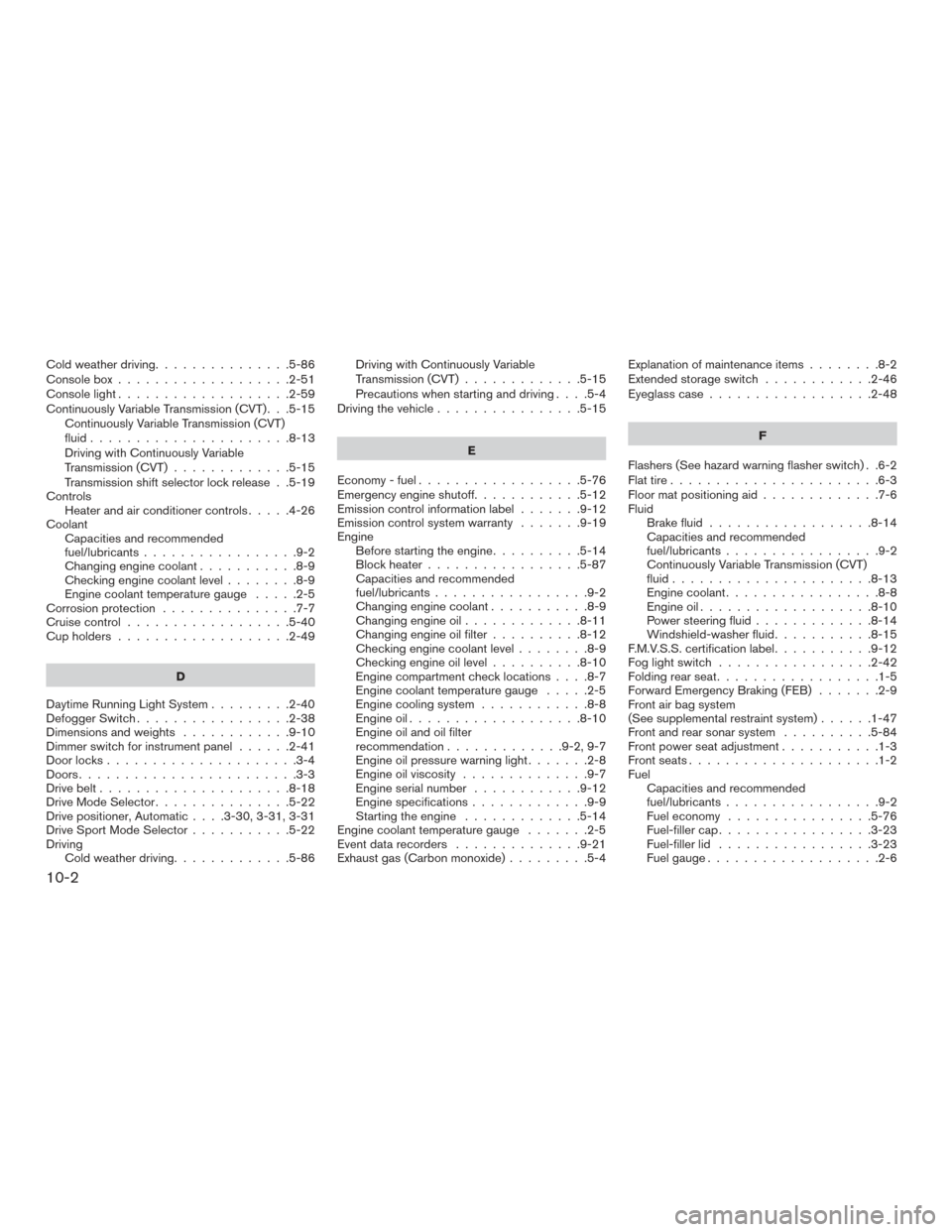
Cold weather driving...............5-86
Consolebox...................2-51
Consolelight...................2-59
Continuously Variable Transmission (CVT) . . .5-15 Continuously Variable Transmission (CVT)
fluid ......................8-13
Driving with Continuously Variable
Transmission (CVT) .............5-15
Transmission shift selector lock release . .5-19
Controls Heater and air conditioner controls .....4-26
Coolant Capacities and recommended
fuel/lubricants .................9-2
Changing engine coolant ...........8-9
Checking engine coolant level ........8-9
Engine coolant temperature gauge .....2-5
Corrosionprotection ...............7-7
Cruisecontrol..................5-40
Cupholders...................2-49
D
Daytime Running Light System .........2-40
Defogger Switch .................2-38
Dimensionsandweights ............9-10
Dimmer switch for instrument panel ......2-41
Door locks .....................3-4
Doors ........................3-3
Drive belt .....................8-18
Drive Mode Selector ...............5-22
Drive positioner, Automatic ....3-30,3-31,3-31
Drive Sport Mode Selector ...........5-22
Driving Cold weather driving .............5-86 Driving with Continuously Variable
Transmission (CVT)
.............5-15
Precautions when starting and driving ....5-4
Driving the vehicle ................5-15
E
Economy - fuel ..................5-76
Emergency engine shutoff ............5-12
Emission control information label .......9-12
Emission control system warranty .......9-19
Engine Before starting the engine ..........5-14
Block heater .................5-87
Capacities and recommended
fuel/lubricants .................9-2
Changingenginecoolant...........8-9
Changingengineoil.............8-11
Changing engine oil filter ..........8-12
Checking engine coolant level ........8-9
Checking engine oil level ..........8-10
Engine compartment check locations ....8-7
Engine coolant temperature gauge .....2-5
Engine cooling system ............8-8
Engineoil...................8-10
Engine oil and oil filter
recommendation .............9-2,9-7
Engine oil pressure warning light .......2-8
Engine oil viscosity ..............9-7
Engine serial number ............9-12
Engine specifications .............9-9
Starting the engine .............5-14
Engine coolant temperature gauge .......2-5
Eventdatarecorders ..............9-21
Exhaust gas (Carbon monoxide) .........5-4Explanation of maintenance items
........8-2
Extended storage switch ............2-46
Eyeglass case ..................2-48
F
Flashers (See hazard warning flasher switch) . .6-2
Flat
tire.......................6-3
Floor mat positioning aid .............7-6
Fluid Brake fluid ..................8-14
Capacities and recommended
fuel/lubricants.................9-2
Continuously Variable Transmission (CVT)
fluid......................8-13
Enginecoolant.................8-8
Engineoil...................8-10
Power steering fluid .............8-14
Windshield-washer fluid ...........8-15
F.M.V.S.S. certification label ...........9-12
Foglightswitch .................2-42
Foldingrearseat..................1-5
Forward Emergency Braking (FEB) .......2-9
Front air bag system
(See supplemental restraint system) ......1-47
Front and rear sonar system ..........5-84
Front power seat adjustment ...........1-3
Frontseats.....................1-2
Fuel Capacities and recommended
fuel/lubricants.................9-2
Fuel economy ................5-76
Fuel-filler cap .................3-23
Fuel-filler lid .................3-23
Fuelgauge...................2-6
10-2
Page 380 of 401

Fuel octane rating...............9-6
Fuel recommendation ..........9-2,9-5
Loose fuel cap warning ...........2-24
Fuel Cell Vehicle (FCV) System Tirepressure.................8-31
Fuel-filler door ..................3-23
Fuel gauge .....................2-6
Fuses.......................8-22
Fusible links ...................8-23
G
Garage door opener, HomeLink® Universal
Transceiver .........2-60,2-63,2-63,2-64
Gascap .....................3-23
Gauge Engine coolant temperature gauge .....2-5
Fuel gauge ...................2-6
Odometer ...................2-4
Speedometer .................2-4
Tachometer ..................2-5
Trip odometer .................2-4
General maintenance ...............8-2
Glovebox.....................2-50
Gloveboxlock..................2-50
H
Hazard warning flasher switch ..........6-2
Headlight and turn signal switch ........2-38
Headlightcontrolswitch ............2-38
Headlights....................8-27
Head restraints ..................1-6
Heated seats ...............2-43,2-45 Heated steering wheel
.............2-45
Heater Heater and air conditioner (automatic)
(if so equipped) ...............4-25
Heater and air conditioner controls .....4-26
Heater operation ...............4-27
Heater and air conditioner (automatic) .....4-25
HomeLink® Universal
Transceiver .........2-60,2-63,2-63,2-64
Hood .......................3-20
Horn .......................2-42
I
Ignition Switch Push-Button Ignition Switch ........5-10
Immobilizer system ............2-35,5-13
Important vehicle information label .......9-12
In-cabin microfilter ................8-20
Increasing fuel economy .............5-76
Indicator NISSAN Intelligent Key® battery discharge
indicator ...................5-13
Indicator lights and audible reminders
(See warning/indicator lights and audible
reminders) ..................2-7,2-12
Inside automatic anti-glare mirror ........3-28
Instrument brightness control ..........2-41
Instrument panel ...............0-6,2-2
Instrument panel dimmer switch ........2-41
Intelligent cruise control (ICC) system Brake assist .................5-42
Intelligent Key system Key operating range ..............3-7
Key operation .................3-8 Mechanical key
................3-3
Remote keyless entry operation.......3-11
Troubleshooting guide ............3-16
Warning signals ...............3-16
Interior light ....................2-58
Interior trunk lid release .............3-22
ISOFIX
child restraints .............1-23
J
Jump starting ................6-8,8-17
K
Key.........................3-2
Key fob battery replacement ..........8-25
Keyless entry With Intelligent Key system
(See Intelligent Key system) .........3-11
Keys NISSAN Intelligent Key® ........3-2,3-6
L
Labels Air conditioner specification label .....9-13
C.M.V.S.S. certification label ........9-12
Emission control information label .....9-12
Engine serial number ............9-12
F.M.V.S.S. certification label .........9-12
Tire and Loading Information label .....9-13
Vehicle identification number (VIN) .....9-11
Vehicle identification number (VIN) plate . .9-11
10-3
Page 381 of 401
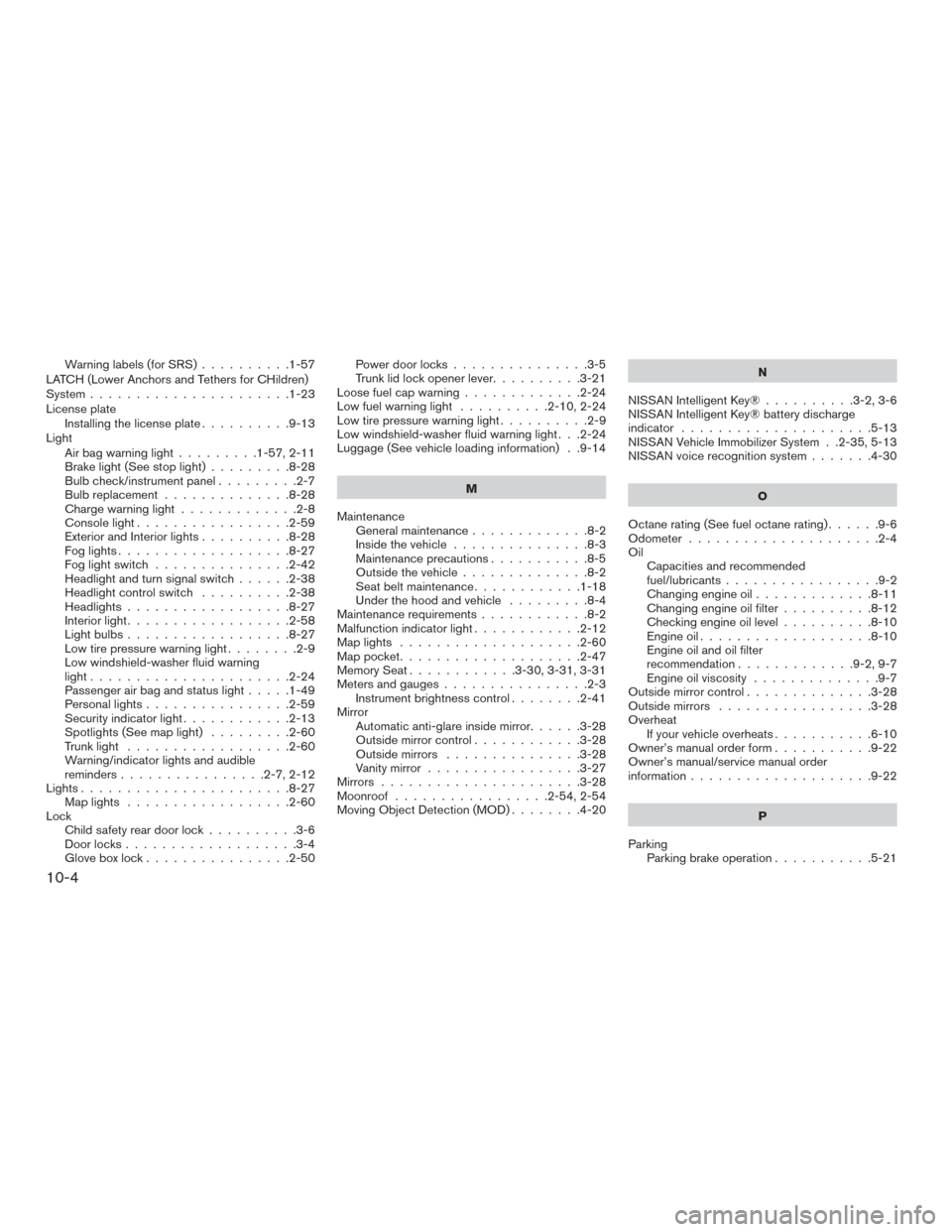
Warning labels (for SRS)..........1-57
LATCH (Lower Anchors and Tethers for CHildren)
System ......................1-23
License plate Installing the license plate ..........9-13
Light Airbagwarninglight.........1-57,2-11
Brake light (See stop light) .........8-28
Bulb check/instrument panel .........2-7
Bulb replacement ..............8-28
Charge warning light .............2-8
Console light .................2-59
ExteriorandInteriorlights..........8-28
Foglights...................8-27
Foglightswitch ...............2-42
Headlight and turn signal switch ......2-38
Headlight control switch ..........2-38
Headlights ..................8-27
Interiorlight..................2-58
Lightbulbs..................8-27
Low tire pressure warning light ........2-9
Low windshield-washer fluid warning
light......................2-24
Passenger air bag and status light .....1-49
Personal lights ................2-59
Security indicator light ............2-13
Spotlights(Seemaplight) .........2-60
Trunklight ..................2-60
Warning/indicator lights and audible
reminders ................2-7,2-12
Lights.......................8-27 Maplights ..................2-60
Lock Child safety rear door lock ..........3-6
Door locks ...................3-4
Gloveboxlock................2-50 Power door locks
...............3-5
Trunk lid lock opener lever ..........3-21
Loose fuel cap warning .............2-24
Lowfuelwarninglight ..........2-10,2-24
Low tire pressure warning light ..........2-9
Low windshield-washer fluid warning light . . .2-24
Luggage (See vehicle loading information) . .9-14
M
Maintenance Generalmaintenance.............8-2
Insidethevehicle...............8-3
Maintenance precautions ...........8-5
Outside the vehicle ..............8-2
Seatbeltmaintenance............1-18
Underthehoodandvehicle .........8-4
Maintenancerequirements............8-2
Malfunction indicator light ............2-12
Maplights ....................2-60
Map pocket ....................2-47
Memory Seat ............3-30,3-31,3-31
Meters and gauges ................2-3
Instrument brightness control ........2-41
Mirror Automatic anti-glare inside mirror ......3-28
Outside mirror control ............3-28
Outside mirrors ...............3-28
Vanity mirror .................3-27
Mirrors ......................3-28
Moonroof .................2-54,2-54
Moving Object Detection (MOD) ........4-20 N
NISSAN Intelligent Key® ..........3-2,3-6
NISSAN Intelligent Key® battery discharge
indicator .....................5-13
NISSAN Vehicle Immobilizer System . .2-35, 5-13
NISSAN voice recognition system .......4-30
O
Octane rating (See fuel octane rating) ......9-6
Odometer .....................2-4
Oil Capacities and recommended
fuel/lubricants.................9-2
Changingengineoil.............8-11
Changing engine oil filter ..........8-12
Checking engine oil level ..........8-10
Engineoil...................8-10
Engine oil and oil filter
recommendation .............9-2,9-7
Engine oil viscosity ..............9-7
Outside
mirror control ..............3-28
Outside mirrors .................3-28
Overheat If your vehicle overheats ...........6-10
Owner’s manual order form ...........9-22
Owner’s manual/service manual order
information ....................9-22
P
Parking Parking brake operation ...........5-21
10-4
Page 388 of 401
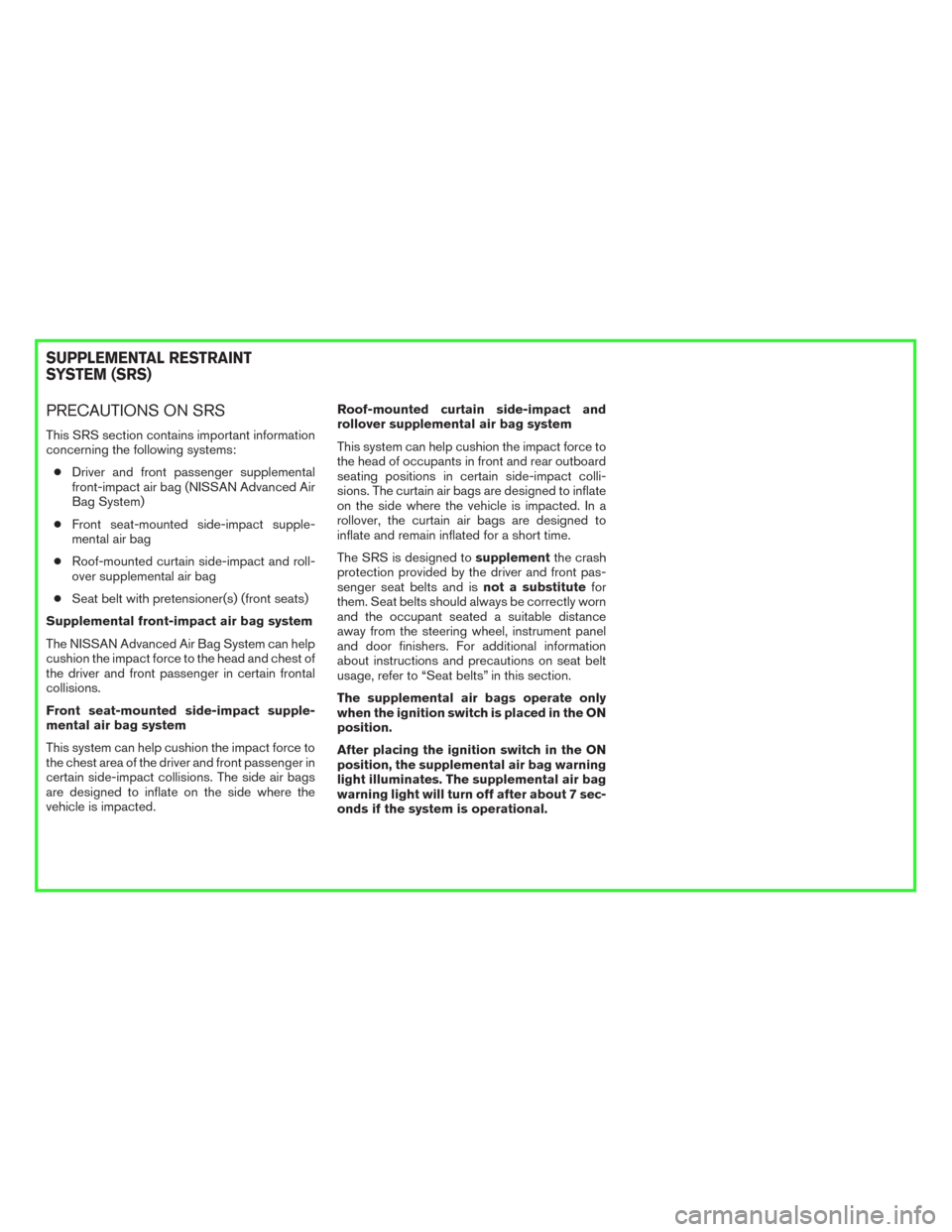
PRECAUTIONS ON SRS
This SRS section contains important information
concerning the following systems:
●Driver and front passenger supplemental
front-impact air bag (NISSAN Advanced Air
Bag System)
●Front seat-mounted side-impact supple-
mental air bag
●Roof-mounted curtain side-impact and roll-
over supplemental air bag
●Seat belt with pretensioner(s) (front seats)
Supplemental front-impact air bag system
The NISSAN Advanced Air Bag System can help
cushion the impact force to the head and chest of
the driver and front passenger in certain frontal
collisions.
Front seat-mounted side-impact supple-
mental air bag system
This system can help cushion the impact force to
the chest area of the driver and front passenger in
certain side-impact collisions. The side air bags
are designed to inflate on the side where the
vehicle is impacted.Roof-mounted curtain side-impact and
rollover supplemental air bag system
This system can help cushion the impact force to
the head of occupants in front and rear outboard
seating positions in certain side-impact colli-
sions. The curtain air bags are designed to inflate
on the side where the vehicle is impacted. In a
rollover, the curtain air bags are designed to
inflate and remain inflated for a short time.
The SRS is designed tosupplementthe crash
protection provided by the driver and front pas-
senger seat belts and isnot a substitutefor
them. Seat belts should always be correctly worn
and the occupant seated a suitable distance
away from the steering wheel, instrument panel
and door finishers. For additional information
about instructions and precautions on seat belt
usage, refer to “Seat belts” in this section.
The supplemental air bags operate only
when the ignition switch is placed in the ON
position.
After placing the ignition switch in the ON
position, the supplemental air bag warning
light illuminates. The supplemental air bag
warning light will turn off after about 7 sec-
onds if the system is operational.
SUPPLEMENTAL RESTRAINT
SYSTEM (SRS)
Page 394 of 401
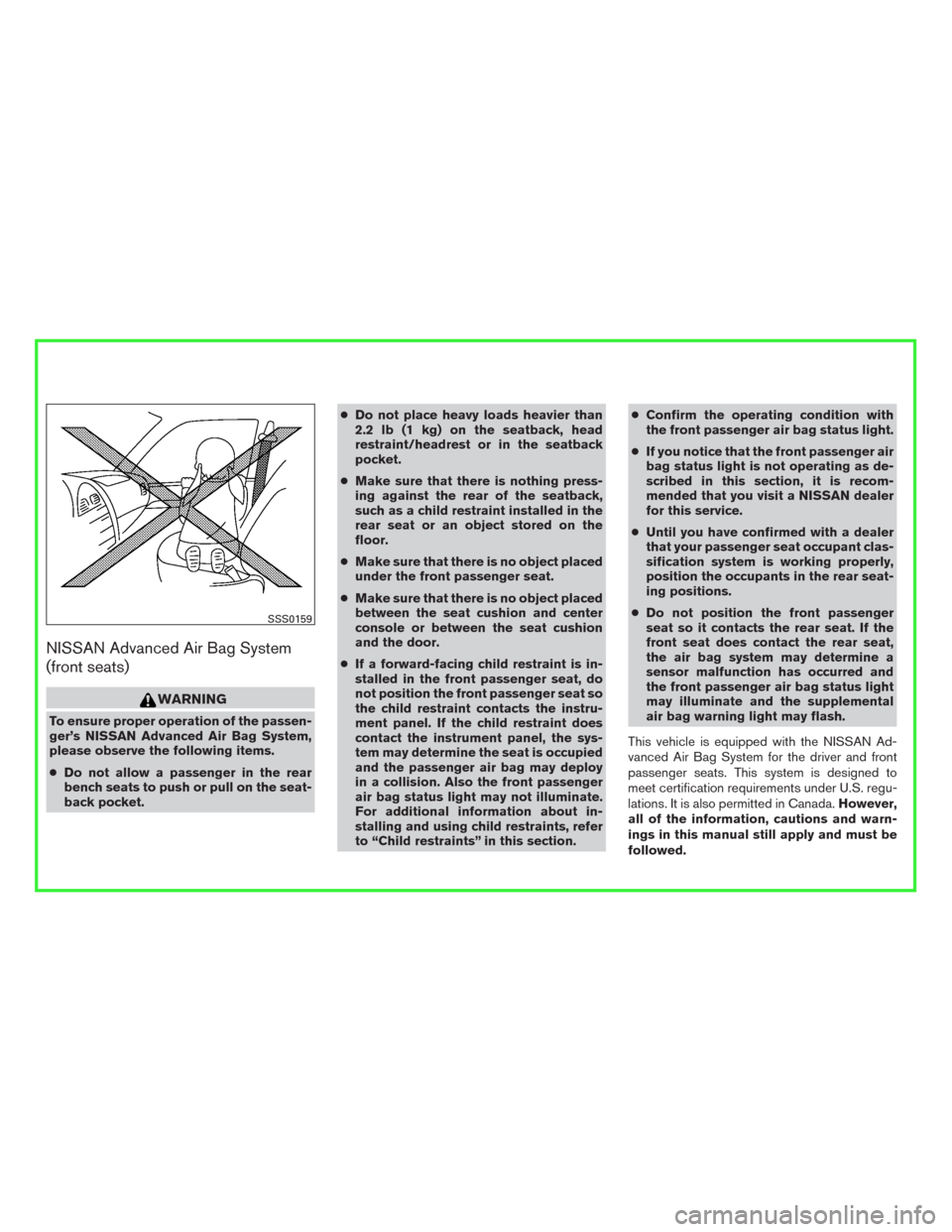
NISSAN Advanced Air Bag System
(front seats)
WARNING
To ensure proper operation of the passen-
ger’s NISSAN Advanced Air Bag System,
please observe the following items.
●Do not allow a passenger in the rear
bench seats to push or pull on the seat-
back pocket.●Do not place heavy loads heavier than
2.2 lb (1 kg) on the seatback, head
restraint/headrest or in the seatback
pocket.
●Make sure that there is nothing press-
ing against the rear of the seatback,
such as a child restraint installed in the
rear seat or an object stored on the
floor.
●Make sure that there is no object placed
under the front passenger seat.
●Make sure that there is no object placed
between the seat cushion and center
console or between the seat cushion
and the door.
●If a forward-facing child restraint is in-
stalled in the front passenger seat, do
not position the front passenger seat so
the child restraint contacts the instru-
ment panel. If the child restraint does
contact the instrument panel, the sys-
tem may determine the seat is occupied
and the passenger air bag may deploy
in a collision. Also the front passenger
air bag status light may not illuminate.
For additional information about in-
stalling and using child restraints, refer
to “Child restraints” in this section.●Confirm the operating condition with
the front passenger air bag status light.
●If you notice that the front passenger air
bag status light is not operating as de-
scribed in this section, it is recom-
mended that you visit a NISSAN dealer
for this service.
●Until you have confirmed with a dealer
that your passenger seat occupant clas-
sification system is working properly,
position the occupants in the rear seat-
ing positions.
●Do not position the front passenger
seat so it contacts the rear seat. If the
front seat does contact the rear seat,
the air bag system may determine a
sensor malfunction has occurred and
the front passenger air bag status light
may illuminate and the supplemental
air bag warning light may flash.
This vehicle is equipped with the NISSAN Ad-
vanced Air Bag System for the driver and front
passenger seats. This system is designed to
meet certification requirements under U.S. regu-
lations. It is also permitted in Canada.However,
all of the information, cautions and warn-
ings in this manual still apply and must be
followed.
SSS0159
Page 395 of 401

The driver supplemental front-impact air bag is
located in the center of the steering wheel. The
front passenger supplemental front-impact air
bag is mounted in the dashboard above the glove
box. The front air bags are designed to inflate in
higher severity frontal collisions, although they
may inflate if the forces in another type of collision
are similar to those of a higher severity frontal
impact. They may not inflate in certain frontal
collisions. Vehicle damage (or lack of it) is not
always an indication of proper front air bag sys-
tem operation.
The NISSAN Advanced Air Bag System monitors
information from the crash zone sensor, the Air
bag Control Unit (ACU) , seat belt buckle sensors
and occupation classification sensor (weight
sensor) . Inflator operation is based on the sever-
ity of a collision and seat belt usage for the driver.
For the front passenger, the occupant classifica-
tion sensor is also monitored. Based on informa-
tion from the sensor, only one front air bag may
inflate in a crash, depending on the crash severity
and whether the front occupants are belted or
unbelted. Additionally, the front passenger air
bag may be automatically turned off under some
conditions, depending on the weight detected on
the front passenger seat and how the seat belt is
used. If the front passenger air bag is OFF, the
front passenger air bag status light will be illumi-
nated. For additional information, refer to “Frontpassenger air bag and status light” in this section.
One front air bag inflating does not indicate im-
proper performance of the system.
If you have any questions about your air bag
system, it is recommended that you visit a
NISSAN dealer to obtain information about the
system. If you are considering modification of
your vehicle due to a disability, you may also
contact NISSAN. Contact information is con-
tained in the front of this Owner’s Manual.
When a front air bag inflates, a fairly loud noise
may be heard, followed by the release of smoke.
This smoke is not harmful and does not indicate a
fire. Care should be taken to not inhale it, as it may
cause irritation and choking. Those with a history
of a breathing condition should get fresh air
promptly.
Front air bags, along with the use of seat belts,
help to cushion the impact force on the face and
chest of the front occupants. They can help save
lives and reduce serious injuries. However, an
inflating front air bag may cause facial abrasions
or other injuries. Front air bags do not provide
restraint to the lower body.
Even with NISSAN Advanced Air Bags, seat
belts should be correctly worn and the driver and
front passenger seated upright as far as practical
away from the steering wheel or instrument
panel. The front air bags inflate quickly in order tohelp protect the front occupants. Because of this,
the force of the front air bag inflating can increase
the risk of injury if the occupant is too close to, or
is against, the front air bag module during infla-
tion.
The front air bags deflate quickly after a collision.
The front air bags operate only when the
ignition switch is in the ON position.
After placing the ignition switch in the ON
position, the supplemental air bag warning
light illuminates. The supplemental air bag
warning light will turn off after about 7 sec-
onds if the system is operational.